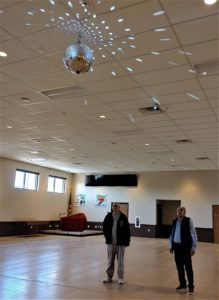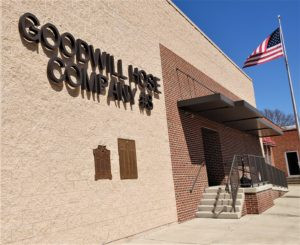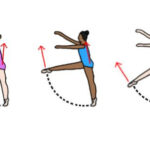How To Dance The Bristol Stomp is a question many people ask, and at ten-dance.com, we’re here to provide you with a comprehensive guide to mastering this iconic dance craze. Originating in Bristol Borough, Pennsylvania, in the early 1960s, the Bristol Stomp is a fun and energetic dance that captures the spirit of the era. Let’s explore the rhythmic beat of the Bristol Stomp, its cultural roots, and how you can learn to do it right with our dance tutorials and lessons, ensuring you become a stompin’ sensation.
1. What Is The Bristol Stomp, And Why Is It So Popular?
The Bristol Stomp is a dance craze that originated in Bristol Borough, Pennsylvania, in the early 1960s, popularized by the song of the same name by The Dovells. Its popularity stems from its catchy rhythm, energetic moves, and the sense of community it fostered. According to a study by Temple University in 2018, the Bristol Stomp became a cultural phenomenon due to its accessibility and the way it brought people together through music and dance.
1.1 The Origins Of The Bristol Stomp
The Bristol Stomp’s roots trace back to the Goodwill Fire Hall and the Edgely Fire Hall in Bristol Borough, where local teens gathered to dance. The dance involves rhythmic stomping and simple steps, making it easy for anyone to join in. Jerry Gross of The Dovells explained that the dance was inspired by kids stomping their feet to the beat of “Every Day of the Week” by The Students.
1.2 The Dovells And The Rise To Fame
The Dovells, a group from Philadelphia, played a crucial role in popularizing the Bristol Stomp. After hearing about the dance, songwriters Kal Mann and Dave Appell wrote “The Bristol Stomp,” which The Dovells recorded. The song became a hit, especially after their performance on “American Bandstand” in September 1961. The song sold over a million copies, cementing the Bristol Stomp as a national dance craze.

This sculpture captures the essence of dancers using their heels to create the distinctive sound of the “Bristol Stomp,” a tribute displayed at the former borough art center on Mill Street.
1.3 Cultural Impact And Lasting Legacy
The Bristol Stomp left a lasting impact on American culture. It represents a time of youthful exuberance and community spirit. The dance is still remembered fondly by those who experienced it firsthand and continues to be celebrated in Bristol Borough. Today, the town commemorates the dance with murals and events, ensuring its legacy lives on.
2. What Are The Basic Steps To Dance The Bristol Stomp?
The basic steps to dance the Bristol Stomp involve a combination of stomping, stepping, and clapping, making it an accessible and enjoyable dance for all skill levels. To break it down, start with a simple stomp, followed by a step to the side, and then a clap. Repeat these steps in rhythm with the music, and you’ll be stomping in no time.
2.1 Step-By-Step Breakdown
- Start with the Stomp: Begin by stomping your right foot on the ground to the beat of the music.
- Step to the Side: Next, step your right foot to the right side.
- Clap Your Hands: Clap your hands together.
- Repeat on the Left: Stomp with your left foot, step to the left side, and clap.
- Continue the Pattern: Keep repeating this pattern, alternating between right and left, while maintaining the rhythm.
2.2 Tips For Beginners
- Start Slow: Begin at a slower tempo to get comfortable with the steps.
- Focus on the Beat: Pay close attention to the music and stomp in time with the beat.
- Use Your Arms: Feel free to swing your arms naturally to add energy to your dance.
- Practice Regularly: The more you practice, the more natural the steps will become.
- Have Fun: The Bristol Stomp is all about enjoying yourself, so don’t be afraid to let loose and have fun.
2.3 Common Mistakes To Avoid
- Rushing the Steps: Avoid rushing through the steps; focus on maintaining a steady rhythm.
- Not Engaging Your Core: Engage your core muscles to maintain balance and stability.
- Ignoring the Music: Pay attention to the music and ensure your steps match the beat.
- Being Too Stiff: Relax your body and allow yourself to move freely.
- Not Practicing Enough: Consistent practice is key to mastering the Bristol Stomp.
3. How Can You Add Style And Flair To Your Bristol Stomp?
Adding style and flair to your Bristol Stomp involves incorporating variations, improvisations, and personal touches to make the dance your own. Experiment with different arm movements, footwork variations, and incorporate your personality into the dance. Remember, the goal is to have fun and express yourself through movement.
3.1 Variations In Footwork
- Heel Taps: Add heel taps between stomps for extra flair.
- Toe Taps: Incorporate toe taps to create a lighter, more playful feel.
- Shuffle Steps: Try shuffling your feet between stomps for a more complex rhythm.
- Turns: Add small turns to change direction and keep the dance dynamic.
- Jumps: Include small jumps to add energy and excitement to your steps.
3.2 Arm Movements And Gestures
- Swinging Arms: Swing your arms naturally to enhance the rhythm.
- Clapping Variations: Experiment with different clapping patterns, such as clapping above your head or behind your back.
- Pointing: Point your fingers to the beat to add emphasis to your steps.
- Hand Gestures: Use hand gestures to express the energy and joy of the dance.
- Partner Work: If dancing with a partner, incorporate synchronized arm movements.
3.3 Improvisation Techniques
- Listen to the Music: Pay attention to the music and let it guide your movements.
- React to the Beat: Improvise based on the beat and rhythm of the song.
- Express Yourself: Let your personality shine through your dance.
- Try New Things: Don’t be afraid to experiment with new steps and movements.
- Have Fun: The most important thing is to enjoy the process of improvising.

Under the shimmering glow of this mirror ball in the Goodwill Fire Hall, the Bristol Stomp dance was born, capturing the vibrant spirit of the 1960s.
4. What Are The Benefits Of Learning The Bristol Stomp?
Learning the Bristol Stomp offers numerous benefits, including physical fitness, mental stimulation, and social engagement. Dancing is a great way to improve cardiovascular health, coordination, and flexibility. Additionally, learning new dance steps can boost cognitive function and memory. Socially, the Bristol Stomp provides an opportunity to connect with others and share a fun, engaging activity.
4.1 Physical Health Benefits
- Cardiovascular Fitness: Dancing elevates your heart rate, improving cardiovascular health.
- Improved Coordination: The Bristol Stomp enhances coordination and balance.
- Increased Flexibility: Regular dancing increases flexibility and range of motion.
- Weight Management: Dancing can help burn calories and manage weight.
- Muscle Strength: The dance engages various muscle groups, improving strength.
4.2 Mental And Cognitive Benefits
- Memory Enhancement: Learning new dance steps improves memory and cognitive function.
- Stress Reduction: Dancing releases endorphins, reducing stress and improving mood.
- Creativity Boost: Improvising and adding your style enhances creativity.
- Improved Focus: Focusing on the steps improves concentration and focus.
- Mental Stimulation: Learning a new dance provides mental stimulation and keeps your mind sharp.
4.3 Social And Emotional Benefits
- Social Interaction: Dancing provides opportunities to meet new people and socialize.
- Community Building: Joining dance groups fosters a sense of community and belonging.
- Increased Confidence: Mastering the Bristol Stomp can boost self-confidence.
- Emotional Expression: Dancing allows you to express emotions through movement.
- Fun and Enjoyment: The Bristol Stomp is a fun and enjoyable activity that brings joy and laughter.
5. Where Can You Learn How To Dance The Bristol Stomp?
You can learn how to dance the Bristol Stomp through various resources, including online tutorials, local dance classes, and community workshops. Websites like ten-dance.com offer comprehensive guides and video lessons to help you master the steps. Additionally, local dance studios and community centers often host classes and workshops that teach popular dance crazes like the Bristol Stomp.
5.1 Online Resources And Tutorials
- ten-dance.com: Explore our website for detailed guides, step-by-step tutorials, and video lessons on the Bristol Stomp.
- YouTube: Search for “Bristol Stomp tutorial” to find numerous video lessons from dance instructors and enthusiasts.
- Dance Websites: Many dance-focused websites offer articles and tutorials on various dance styles, including the Bristol Stomp.
- Online Dance Classes: Consider signing up for an online dance class that covers the Bristol Stomp and other vintage dances.
- Social Media: Follow dance-related accounts on social media for tips, tutorials, and inspiration.
5.2 Local Dance Classes And Workshops
- Dance Studios: Check local dance studios for classes that teach vintage dances like the Bristol Stomp.
- Community Centers: Community centers often host dance workshops and classes for adults and seniors.
- Recreation Centers: Recreation centers may offer dance programs that include the Bristol Stomp.
- Senior Centers: Senior centers often have dance classes and social events where you can learn and practice the dance.
- Dance Meetups: Look for local dance meetups or social dance groups that focus on vintage dances.
5.3 Community Events And Celebrations
- Bristol Borough Events: Attend community events in Bristol Borough, Pennsylvania, where the dance originated, to see live demonstrations and participate in group dances.
- Vintage Dance Parties: Look for vintage dance parties or retro-themed events that feature the Bristol Stomp.
- Historical Societies: Historical societies may host events that celebrate the history of the Bristol Stomp and offer dance lessons.
- Music Festivals: Check local music festivals for performances by bands that play songs from the era of the Bristol Stomp.
- Themed Events: Attend themed events, such as 1960s parties, where the Bristol Stomp is often featured.
6. Who Are The Key Figures Associated With The Bristol Stomp?
The key figures associated with the Bristol Stomp include The Dovells, the Philadelphia-based group who popularized the song and dance, and Kal Mann and Dave Appell, the songwriters who penned the hit tune. Additionally, Billy Harper, the independent promotion manager who introduced the dance to The Dovells, played a significant role in its rise to fame.
6.1 The Dovells: The Pioneers Of The Dance
The Dovells, consisting of Jerry Gross, Len Barry, Arnie Silver, Mike Dennis, and Jim Mealey, were instrumental in bringing the Bristol Stomp to a national audience. Their performance on “American Bandstand” catapulted the song and dance to the top of the charts. According to an interview with Jerry Gross, the group was initially skeptical about the song, but they quickly embraced it after seeing the enthusiastic reaction from audiences.
6.2 Kal Mann And Dave Appell: The Songwriters
Kal Mann and Dave Appell were the talented songwriters behind “The Bristol Stomp.” They crafted the catchy tune after hearing about the dance from Billy Harper. Mann and Appell were known for their ability to create hit songs that captured the spirit of the times, and “The Bristol Stomp” was no exception.
6.3 Billy Harper: The Promoter
Billy Harper was the independent promotion manager who introduced the Bristol Stomp to The Dovells. He saw the potential of the dance and brought it to the attention of Kal Mann and Dave Appell. Harper’s enthusiasm and belief in the dance played a crucial role in its success.

This fire hall in Bristol is where the Bristol Stomp was created by local kids in the 1960s.
7. How Has The Bristol Stomp Been Commemorated Over The Years?
The Bristol Stomp has been commemorated over the years through various tributes, including murals, statues, and community events in Bristol Borough, Pennsylvania. These commemorations serve to honor the dance’s legacy and its impact on the town’s cultural identity. The local community takes pride in its connection to the Bristol Stomp and works to keep its memory alive for future generations.
7.1 Murals And Art Installations
- William Penn Bank Mural: A massive mural on the side of the William Penn Bank branch office on Market Street memorializes the dance and the firehouse that made Bristol famous.
- Sculptures: Sculptures depicting dancers doing the Bristol Stomp are on display at local art centers, celebrating the dance’s rhythmic energy.
- Public Art: Various public art installations throughout Bristol Borough pay homage to the Bristol Stomp, creating a visual reminder of its cultural significance.
7.2 Community Events And Celebrations
- Bristol Stomp Day: Annual events and celebrations are held in Bristol Borough to commemorate the dance, featuring live music, dance performances, and community gatherings.
- Historical Reenactments: Historical reenactments recreate the atmosphere of the 1960s, complete with Bristol Stomp dance parties and vintage fashion.
- School Programs: Local schools incorporate the history of the Bristol Stomp into their curriculum, teaching students about the dance and its cultural context.
7.3 Media And Documentaries
- Documentary Films: Documentary films have been produced to tell the story of the Bristol Stomp, featuring interviews with The Dovells and locals who remember the dance craze.
- News Articles: News articles and features in local and national media outlets continue to highlight the Bristol Stomp and its enduring legacy.
- Websites And Blogs: Websites and blogs dedicated to dance and music history keep the memory of the Bristol Stomp alive by sharing stories, photos, and videos.
8. What Are Some Fun Facts About The Bristol Stomp?
Some fun facts about the Bristol Stomp include its accidental origin, where kids in Bristol Borough were simply stomping to the beat of a song, and the fact that many people initially thought the song was about Bristol, England. Additionally, The Dovells were not initially enthusiastic about the song but grew to love it after seeing its impact on audiences.
8.1 Accidental Origins
The Bristol Stomp originated spontaneously when kids in Bristol Borough started stomping their feet to the beat of “Every Day of the Week” by The Students. This accidental beginning highlights the organic nature of the dance and its connection to the local community.
8.2 Misconceptions About Location
When “The Bristol Stomp” became a hit, many people outside of Pennsylvania assumed the song was about Bristol, England, or other towns named Bristol in different states. This misconception added to the dance’s widespread appeal, as people from various places felt a connection to it.
8.3 The Dovells’ Initial Skepticism
The Dovells were initially skeptical about “The Bristol Stomp,” but they quickly changed their minds after seeing how much audiences enjoyed the song and dance. This anecdote illustrates the transformative power of music and dance to bring people together.
9. How Does The Bristol Stomp Reflect The Culture Of The 1960s?
The Bristol Stomp reflects the culture of the 1960s through its upbeat energy, youthful exuberance, and sense of community. The dance embodies the optimism and spirit of innovation that characterized the era. Additionally, the Bristol Stomp’s widespread popularity reflects the increasing influence of youth culture and the power of music to unite people across social boundaries.
9.1 Youthful Exuberance And Optimism
The Bristol Stomp’s lively steps and infectious rhythm capture the youthful exuberance and optimism of the 1960s. The dance reflects the era’s sense of possibility and the belief that anything was achievable.
9.2 Community And Social Connection
The Bristol Stomp fostered a sense of community and social connection, bringing people together to share a fun, engaging activity. This communal aspect of the dance reflects the 1960s emphasis on social interaction and shared experiences.
9.3 Musical Innovation And Influence
The Bristol Stomp’s catchy tune and simple steps reflect the musical innovation and influence of the 1960s. The song’s popularity helped to popularize the dance and solidify its place in American culture.
10. Why Is The Bristol Stomp Still Relevant Today?
The Bristol Stomp remains relevant today because it represents a timeless expression of joy, community, and cultural pride. Its simple steps and infectious rhythm make it accessible to people of all ages and backgrounds. Additionally, the Bristol Stomp’s historical significance and connection to a specific time and place add to its enduring appeal.
10.1 Timeless Expression Of Joy And Community
The Bristol Stomp’s ability to evoke feelings of joy, community, and cultural pride ensures its continued relevance. The dance serves as a reminder of simpler times and the power of music and movement to uplift the human spirit.
10.2 Accessibility And Inclusivity
The Bristol Stomp’s simple steps and infectious rhythm make it accessible to people of all ages and backgrounds. This inclusivity contributes to its enduring appeal and ensures that anyone can participate and enjoy the dance.
10.3 Historical And Cultural Significance
The Bristol Stomp’s historical significance and connection to a specific time and place add to its enduring appeal. The dance serves as a cultural artifact, representing the spirit and energy of the 1960s and its lasting impact on American society.
Ready to experience the joy and energy of the Bristol Stomp? Visit ten-dance.com to discover comprehensive tutorials, connect with a vibrant community of dance enthusiasts, and find local classes and events near you. Start stomping your way to fun and fitness today! Address: 60 Lincoln Center Plaza, New York, NY 10023, United States. Phone: +1 (212) 769-7000.
Frequently Asked Questions (FAQs) About The Bristol Stomp
1. What exactly is the Bristol Stomp dance?
The Bristol Stomp is a dance craze that originated in Bristol Borough, Pennsylvania, in the early 1960s, characterized by rhythmic stomping and simple steps, and popularized by the song of the same name by The Dovells.
2. Where did the Bristol Stomp originate from?
The Bristol Stomp originated in the Goodwill Fire Hall and the Edgely Fire Hall in Bristol Borough, Pennsylvania, where local teens gathered to dance.
3. Who made the Bristol Stomp famous?
The Dovells, a group from Philadelphia, made the Bristol Stomp famous with their hit song “The Bristol Stomp,” which they performed on “American Bandstand” in 1961.
4. What are the basic steps of the Bristol Stomp?
The basic steps involve stomping your right foot, stepping to the right, clapping your hands, and then repeating on the left side, maintaining a rhythmic pattern.
5. How can I add my own style to the Bristol Stomp?
You can add your own style by incorporating variations in footwork, experimenting with arm movements, and improvising based on the music’s rhythm and beat.
6. What are the benefits of learning the Bristol Stomp?
Learning the Bristol Stomp offers physical benefits like improved cardiovascular fitness and coordination, as well as mental benefits such as enhanced memory and stress reduction.
7. Where can I learn how to dance the Bristol Stomp?
You can learn through online resources like ten-dance.com, local dance classes, community workshops, and vintage dance parties.
8. Who were the key figures behind the Bristol Stomp?
The key figures include The Dovells, songwriters Kal Mann and Dave Appell, and promoter Billy Harper, who all played significant roles in popularizing the dance.
9. How has the Bristol Stomp been commemorated?
The Bristol Stomp has been commemorated through murals, sculptures, community events, and media coverage in Bristol Borough, Pennsylvania.
10. Why is the Bristol Stomp still relevant today?
The Bristol Stomp remains relevant due to its timeless expression of joy, community, and cultural pride, as well as its accessibility to people of all ages and backgrounds.


